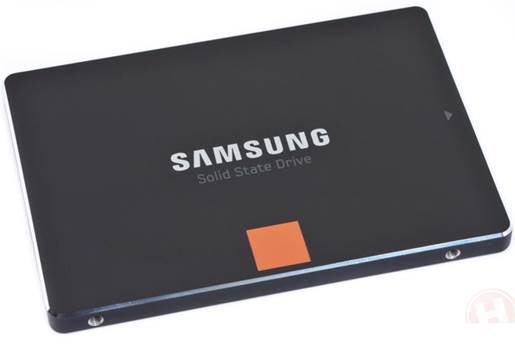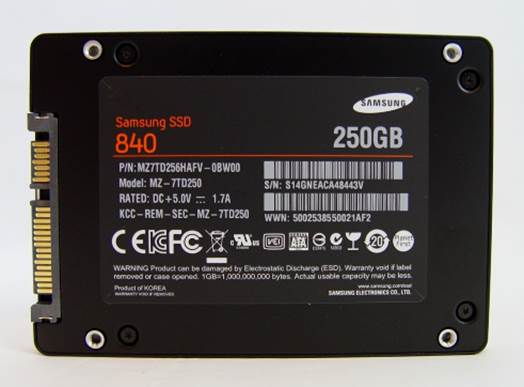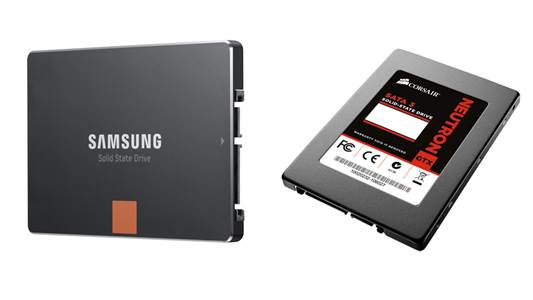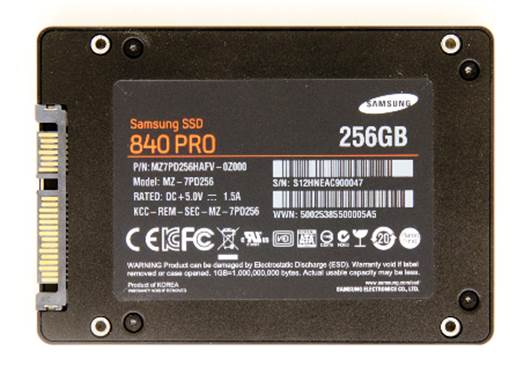Vital statistics
·
Price: $256
·
Manufacturer: Samsung
·
Web: www.samsung.com
·
Capacity: 250GB
·
Memory type: TLC toggle
·
Controller: Samsung MDX
·
Interface: SATA 6Gbps
·
Peak performance: 540MB/sread, 250MB/s write
·
Max IOPS: 96k

Samsung
840 250GB
Finally, the SSD industry is getting a
little TLC. A painfully obvious pun, perhaps, but the arrival of triple-level
cell flash memory in a mainstream SSD is such a big deal, we're willing to take
the flack.
That Samsung is the one to deliver it,
however, is not a huge surprise. The Korean giant is currently cranking out
world-beating kit in several segments, from smartphones to ARM chips and HDTVs.
That includes pushing the boundaries of SSD
tech. Samsung is pretty much alone these days in being able to bring together
the key ingredients inside a solid-state drive. No other company does its own
flash memory, controller chipset and even DRAM. It's the complete Samsung
package.
Of course, that in-house edge means Samsung
can give itself first dibs with key developments. No doubt its new TLC memory
will appear fairly soon in a wide range of SSDs from several brands. But here
and now, it's unique to the new Samsung 840.
The big win with TLC memory is, obviously,
data density. The ability to store three bits per cell means an increase of 50
per cent over conventional MLC flash in terms of data density, and in turn
promises a drop in SSD prices at a given capacity.
The pricing part of the package hasn't
happened immediately. But we doubt it will be long before the influence of TLC
flash can be seen throughout the industry in the form of lower prices. Hurrah.
However, there's more to TLC than mere
capacity, and it's not all good. In very simple terms, TLC memory is both
slower and less robust. It can’t cope with as many write-and- erase cycles as
MLC memory. That's probably why Samsung is reluctant to quote exactly how many
of those cycles its new TLC chips can swallow.
Poor endurance
But really roughly, you're looking at
around one third the longevity per cell of equivalent MLC memory. We also know
that this new TLC memory has greater read and write latencies than MLC flash.
Suddenly then, TLC doesn't sound like such a great idea after all.

Samsung
840 250GB
Sure enough, if you scan the spec sheet
you’ll find the new 840 is actually slower than the old 830 in some areas. Most
notably sequential write performance, which drops from 400MB/s to just 250MB/s.
Yikes.
But the 840 is also faster in other areas,
including peak IOPS which are slightly up for reads and almost doubled for
writes. The poorer endurance rating probably isn’t the disaster it first seems,
either. Even a pessimistic calculation of longevity involving daily usage would
put the likely lifespan at well over five years. Samsung provides a warranty
for three years.
As our benchmark results show, the 840’s
performance is pretty decent where it counts. It's competitive in our
application tests and ponies up 4k random reads and writes that would have
looked world-beating only a few months ago.
That doesn't make the new 840 a must-buy
proposition immediately. For that we'll have to wait for the price advantages
of TLC memory to fully kick in. But this SSD is only going to get more tasty as
the price tumbles.
Samsung 840 Pro 256GB
Vital statistics
·
Price: $334.4
·
Manufacturer: Samsung
·
Web: www.sam5ung.co.uk
·
Capacity: 256GB
·
Memory type: TLC toggle
·
Controller: Samsung MDX
·
Interface: SATA 6Gbps
·
Peak performance: 540MB/s read, 450MB/s write
·
Max IOPS: 100k

Samsung
840 Pro 256GB
Yes, we know what you're thinking. Well
over $320 for a 256GB SSD? Aren't SSD prices supposed to be going down, not up?
Generally speaking, the answer would be a clear affirmative. But there’s always
space for something a little special at the top of the price lists.
The question Samsung's asking, therefore,
is just how much are you willing to pay for the ultimate in SSD oomph. Perhaps
the toughest comparison for the 840 Pro is Samsung's own 830, which can be had
in equal 256GB capacity for about $96 less. The new drive is going to need some
pretty nifty moves to justify that price differential.
Technologically speaking, there's a triple
whammy of critical enablers that might just make that possible: new flash
memory, new firmware and a new controller chipset. The new memory is Samsung
21nm Toggle NAND complete with a 400Mbps interface.
Meanwhile, the controller is Samsung's
fourth-generation effort, known as MDX. The chip's spec include three ARM
Cortex R4 cores running at around 300MHzand the same controller you'll find in
the much cheaper 840 non-pro.
For context, the old 830 series drive had a
triple-core controller based on ARM cores and running at 220MHz and Toggle 1.0
NAND rated at 133Mbps.Sothe big difference in terms of performance you can
likely trace to the flash memory in each drive.
As for the firmware, we don’t have any new
data to divulge. But we can confirm that the foreground garbage collection
feature from the 830's MCX controller remains, which bodes well for long-term
reliability. On a related note, the 840 Pro comes with a standard five-year
warranty, while the plain 840 makes do with three-year cover.
Rounding out the hardware is 512MB of
1,066MHz DDR2 DRAM cache memory. By default, spare memory area is set to around
seven percent of capacity, though that's adjustable using Samsung SSD Magician
tool.
Losing the magic
If that's the 840 Pro on paper, what's it
like driving data round your desktop? Pretty darn good, on the whole. There is
a proviso attached to this drive though, and not of its own making. Our test
sample had been round the block once before and Samsung didn't make its SSD
Magician software tool available to help us do a factory reset.

Samsung
840 Pro 256GB
That explains why a few of the performance
numbers are a tad disappointing. We know, for instance, that it will do over
70MB/sin the ASSSD4K random write test in box-fresh condition. The 59MB/s that
it achieves in our benchmarks is still good but it's just not as spectacular as
it might have been. Of course, box freshness is not a terribly realistic state.
To reflect that, we also gave each drive an
endurance test. For quite a few drives, the result was a pretty significant
performance drop off. For the 840 Pro, what damage there was had already been
done.
The only slight snag was that OCZ's Vertex
4 also ran the endurance test and managed to maintain its over 70MB/s speed. In
objective terms, then, the new 840 Pro isn't quite the quickest drive you can
buy.